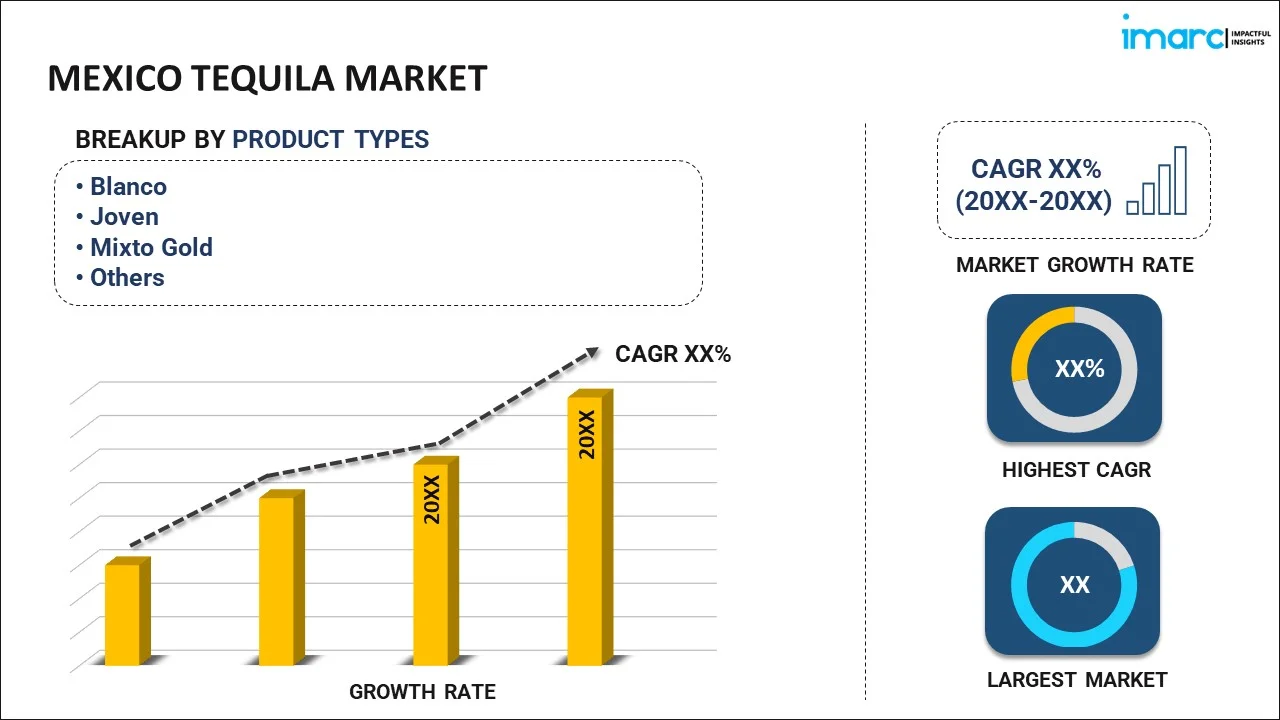
Mexico Tequila Market Report by Product Type (Blanco, Joven, Mixto Gold, Reposado, Anejo, Extra Anejo), Purity (100% Tequila, 60% Tequila), Price Range (Premium Tequila, Value Tequila, Premium and Super-Premium Tequila, Ultra-Premium Tequila), Distribution Channel (Off-Trade, On-Trade), and Region 2025-2033
Market Overview:
The Mexico tequila market size reached USD 5.0 Billion in 2024. Looking forward, IMARC Group expects the market to reach USD 12.9 Billion by 2033, exhibiting a growth rate (CAGR) of 10.45% during 2025-2033.
|
Report Attribute
|
Key Statistics
|
|---|---|
|
Base Year
|
2024
|
|
Forecast Years
|
2025-2033
|
|
Historical Years
|
2019-2024
|
|
Market Size in 2024
|
USD 5.0 Billion |
|
Market Forecast in 2033
|
USD 12.9 Billion |
| Market Growth Rate (2025-2033) | 10.45% |
Tequila is an alcoholic beverage that is obtained from the fermented juice of the Mexican agave plant. It is often filtered through carbon filters in cold temperatures to remove the excess fatty compounds that give tequila a cloudy appearance. The moderate consumption of tequila is known to aid digestion, increase the probiotic levels, enhance the absorption of calcium and magnesium, and support the growth of healthful microbes in the intestines. In Mexico, tequila is a popular alcoholic beverage, especially among the young consumers who use it as a base for a wide variety of cocktails.
The Mexico tequila market is primarily driven by the premiumization of the product, the changing drinking habits of the consumer and the growing cocktail culture. The introduction of new variants produced with craft cocktails and natural ingredients like lemon, coconut, tangerine, strawberry, pineapple, mango, and pear is also propelling the growth of the market. As Mexico is the top producer of tequila, its inclusion in essential agricultural products has allowed continuous production and non-disrupted supply. As a result, there have been increasing exports of tequila to the US, Russia and Germany, which is providing a significant impact on the market growth. Moreover, the large production of tequila in Mexico provides cost-benefit to consumers, thereby increasing its demand across the country.
Key Market Segmentation:
IMARC Group provides an analysis of the key trends in each sub-segment of the Mexico tequila market report, along with forecasts at the country and regional level from 2025-2033. Our report has categorized the market based on product type, purity, price range and distribution channel.
Breakup by Product Type:

- Blanco
- Joven
- Mixto Gold
- Reposado
- Anejo
- Extra Anejo
Breakup by Purity:
- 100% Tequila
- 60% Tequila
Breakup by Price Range:
- Premium Tequila
- Value Tequila
- Premium and Super-Premium Tequila
- Ultra-Premium Tequila
Breakup by Distribution Channel:
- Off-Trade
- Supermarkets and Hypermarkets
- Discount Stores
- Online Stores
- Others
- On-Trade
- Restaurants and Bars
- Liquor Stores
- Others
Breakup by Region:
- North
- Center
- West
- East
Competitive Landscape:
The competitive landscape of the industry has also been examined along with the profiles of the key players.
Report Coverage:
| Report Features | Details |
|---|---|
| Base Year of the Analysis | 2024 |
| Historical Period | 2019-2024 |
| Forecast Period | 2025-2033 |
| Units | Billion USD |
| Segment Coverage | Product Type, Purity, Price Range, Distribution Channel, Region |
| Region Covered | North, Center, West, East |
| Customization Scope | 10% Free Customization |
| Post-Sale Analyst Support | 10-12 Weeks |
| Delivery Format | PDF and Excel through Email (We can also provide the editable version of the report in PPT/Word format on special request) |
Key Questions Answered in This Report:
- How has the Mexico tequila market performed so far and how will it perform in the coming years?
- What has been the impact of COVID-19 on the Mexico tequila market?
- What are the key regional markets?
- What is the breakup of the market based on the product type?
- What is the breakup of the market based on the purity?
- What is the breakup of the market based on the price range?
- What is the breakup of the market based on the distribution channel?
- What are the various stages in the value chain of the industry?
- What are the key driving factors and challenges in the industry?
- What is the structure of the Mexico tequila market and who are the key players?
- What is the degree of competition in the industry?
Need more help?
- Speak to our experienced analysts for insights on the current market scenarios.
- Include additional segments and countries to customize the report as per your requirement.
- Gain an unparalleled competitive advantage in your domain by understanding how to utilize the report and positively impacting your operations and revenue.
- For further assistance, please connect with our analysts.
 Inquire Before Buying
Inquire Before Buying
 Speak to an Analyst
Speak to an Analyst
 Request Brochure
Request Brochure
 Request Customization
Request Customization




.webp)




.webp)












